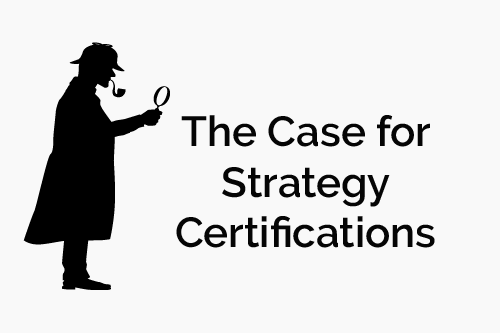
The Case for Strategy Certifications
The success of the organization is dependent upon the human capital element of your organizational capacity.

The success of the organization is dependent upon the human capital element of your organizational capacity.

One of the best-loved classics viewed during the Christmas season is Charles Dickens’ A Christmas Carol (see summary here), a story centered around a selfish and unfriendly old man who hates Christmas named Ebenezer Scrooge. It is a story that has been recreated for film, television and the stage more than two dozen times and offers many valuable leadership lessons.
Leadership Lessons from Christmas Past
There is an urban legend regarding an incident about a young pilot in the U.S. Navy who crashed his $38 million F-14 Tomcat and had to appear before the Investigation Board. After providing his perspective on the details of the crash, the young pilot asked an Admiral who was sitting on that Board if he would lose his wings. The Admiral stared at him for a moment and then stated, “Why would we take your wings when the U.S. Navy just spent $38 million dollars training you?”
Good leaders learn from past mistakes and don’t repeat them in the future. Sometimes the best lessons learned come from our mistakes and failures. In A Christmas Carol, Scrooge saw the mistakes he had made and the opportunities that had passed him by. While unable to change the past, he still had the opportunity to learn from his mistakes and ensure they were not repeated in the future. There is no value in berating employees or constituents on what happened yesterday, as you can’t change it. Objectively and honestly analyze your successes and failures and try to learn the lessons that each have to offer.
Leadership Lessons from Christmas Future
Many have attempted to predict future events throughout history. Sometimes, a few got some of it right, but the vast majority missed the mark substantially. The one thing you can be certain about regarding the future is uncertainty. With the rapidly changing circumstances, technology, social reforms and everything else requiring attention in today’s world, an organization must be proactive if it wants to survive in the long-term. As the predictability of future events is generally a best guess based on past history, predictive analysis and other tools, organizational agility and flexibility are essential for success in today’s ever-changing environment.
Are you growing your employees? Are you equipping them with the skills, abilities and freedom to innovate; to be creative and involved in decisions that form the basis for the future of the organization? Is succession planning a viable part of your strategy? Are you grooming the right people to take the leadership reins of your organization in the coming decades? Have you studied and learned from the past? Are you doing things differently based on what you have learned? Is your organizational culture one of empowerment and change, focused on the future or stuck in the past doing the same things, in the same way, buried in layers of bureaucracy and mediocracy? Scrooge didn’t just learn from the past, he applied that learning to his future. He was willing to make the changes necessary and provide others with the support and encouragement necessary to succeed.
Leadership Lessons from Christmas Present
Recent studies show approximately 64% of executives struggle with work related stress. This impacts their ability to sleep, relax and their health. If this is true for executives, it is reasonable to suggest that many employees below the executive level of an organization also struggle with similar issues. Holidays are often a mixed bag when it comes to stress at both work and home.
In this season of Christmas, carve some time out of your schedule to relax without the worry of work. Spend additional time with your family, friends, colleagues and employees. Turn off the cell phone and don’t worry about emails for a few hours or a few days, if possible. The holidays will be here and gone before you know it and once gone, they are in the past. Make some warm memories with the ones that you love. Be kind to one another and be generous to those in need.
From all of us at the Strategy Management Group to all of you, we wish you, your family and friends, a wonderful holiday season.
Sources
A Christmas Carol Summary by Charles Dickens. Retrieved from: https://www.sparknotes.com/lit/christmascarol/summary/
Grumman F-14 Tomcat. Retrieved from:
https://www.aircraftcompare.com/aircraft/grumman-f-14-tomcat/
The Stressed Executive: Sources and Predictors of Stress Among Participants in an Executive Health Program, U.S. National Library of Medicine. Retrieved from: https://www.ncbi.nlm.nih.gov/pmc/articles/PMC6196623/

 Over the last 10 years we have seen a tremendous change in the healthcare industry. Whether it is a shift in philosophy to focus on more value-based care or navigating the impact of implementing the Affordable Care Act here in the United States, significant shifts and changes have occurred and are occurring every day. Given the relative unpredictability of how the healthcare market will change, is there really any use for those in the industry to go through a strategic planning initiative? The answer is of course yes, but the real question is “how?”
Over the last 10 years we have seen a tremendous change in the healthcare industry. Whether it is a shift in philosophy to focus on more value-based care or navigating the impact of implementing the Affordable Care Act here in the United States, significant shifts and changes have occurred and are occurring every day. Given the relative unpredictability of how the healthcare market will change, is there really any use for those in the industry to go through a strategic planning initiative? The answer is of course yes, but the real question is “how?”
To be successful in the future, no matter how turbulent the path forward may be, organizations need to create a vision based on the best future assumptions they can identify. With any strategic planning effort is it really important to have at its foundation key assumptions about how the world will be different. Organizations then can describe what they need to look like given those future assumptions, and then design a strategy to help them bridge the gap between where they are today and achieving that future success. But if all our assumptions of the future are up in the air, then how can we really build a strategy effectively?
I would argue that in industries that are experiencing a lot of change it is even more important to be strategic! Yes, there are many unknowns given the relative volatility of the US political landscape as it pertains to healthcare. But there are some key assumptions that can be made that are relative certainties regardless of any potential future political or regulatory shifts? If we can identify those “most probable” assumptions in the healthcare industry or in our particular marketplace, then it would be worth our time to identify them and begin building our response strategies accordingly. I would like to present the follow set of ideas as examples of assumptions that most participants in the healthcare sector need to consider over the next five years and could be the basis for strategic discussion. These are not meant to be all inclusive, but merely to demonstrate that there are fundamental assumptions that can be identified even in a marketplace where significant uncertainty exists.
The need to provide ever increasing quality patient care will continue. The focus over the next five years will continue to be on delivering highly impactful, cost-effective healthcare. Whether it is driven by key stakeholder requirements or customer expectations, we know that successful players in the healthcare industry will be those that can generate healthy outcomes for their patients. Fundamentally having strategies built around improved effectiveness and efficiency in delivering quality patient care will be a fundamental requirement in the future. No real surprises but any strategic discussion in the healthcare sector must begin with patient care! The point is that the ability to differentiate regarding healthcare outcomes will be the bases for any future success in the industry.
Changing in customer volume and demographics will continue. The fact is that the US population is going to continue to grow over the next five years. In May of 2017, the US passed the 325 million mark and is expected to be over 332 million by 2020 (US Census data). That means essentially there will be more people needing care in the future with some healthcare markets seeing fairly dramatic increases in patient populations. We have seen a significant impact in demographic shifts in the US over the last five years and this trend will continue over the next five years as the increases in Hispanic and Asian demographic groups continues at a high rate. How will these assumptions impact capacity requirements or service delivery requirements within the healthcare sector?
Labor supply changes. The US has seen labor supply grow by 2.6 percent per year over the last decade, but that trend will not continue. Rand researchers (Karoly & Panis, 2004) have postulated that the growth of labor supply will only be around .04 percent over the next decade and will be even smaller the following decade. Also, while the trend has been a more aging workforce over the last 20 years this will also change with the workforce being more evenly balanced across age groups in the future. How will this impact the availability of skill workers and experience levels in the healthcare industry? What does this mean for how we need to recruit and retain of workforce?
Continued increase on wellness and prevention. Significant increase in innovation with regard to nutrition for example will be driven by increase consumer demand for wellness. Patients are sharing that they want advice on weight management and diet therapies (PwC Health Research Institute, 2016) for example leading to increased focus on these services within the industry. Smoking cessation and fitness programs are other programs that are already tied to health outcomes and will continue to be important in the future. How will this trend impact the future services healthcare practitioners will provide? Or the information they make available to their patients?
Emerging technologies in the healthcare marketplace. PWC reports that “the US health industry lags behind other industries, such as retail and telecommunications, in deploying emerging technologies, including artificial intelligence, drones and virtual reality but that this trend is about to change.” (PwC Health Research Institute, 2016). Accenture reports that “the global healthcare industry in the year 2020 will be a highly connected environment powered by large data networks, cloud computing, and mobile devices. There will be widespread increases in the number of connected healthcare networks providing seamless integration between care providers, patients, pharmaceutical companies, health insurers, and other invested parties anywhere in the world. Care within this model will become more patient-centric, less expensive to provide, and more innovative.” (Meissner, 2013). These assumptions would call for a need to invest in breakthrough technologies that impact how patient care is provided and operational business processes are managed moving forward. This will also impact the types of skills needed in the future within the industry.
Rising operating costs driven by government regulations and expanded capacity requirements will impact the financial viability of healthcare systems (Jonash & Ronanki, 2015). Healthcare CEO’s and COO’s must find innovative was to drive revenue and decrease costs. How will rising costs impact the future viability of healthcare providers? How must they change how they do business? In what areas must they innovate to reduce costs?
I share these discussion points as merely a sampling of assumptions that could be discussed by healthcare industry players in formulating their 3-5-year strategies. With proper research conducted, there are dozens of additional assumptions that we could discuss to really understand the future of the healthcare industry. I provide these few ideas as evidence that even in an industry that is experiencing rapid, constant change, there is a need to really understand how the world will be different in the future. To do so, we must first understand what assumptions can be made and set out to use a strategic planning framework to understand how our healthcare organization must transform in the future in the face of those assumptions. Once we are able to articulate that future successful state, we can then work to understand what must be accomplished to get from where we are today to achieving the needed transformation that must take place in the next few years – our strategy becomes the path and the plan to future success.
Sources:
Jonash, Ben & Rajeev Ronanki (2015). The convergence of health care trends: Innovation strategies for emerging opportunities. Retrieved from: https://www2.deloitte.com/us/en/pages/life-sciences-and-health-care/articles/convergence-health-care-trends.html?id=us::3bi:confidence:eng:cons::::qQmDoWY2::77378163007585:bb:::nb
Karoly, Lynn A. and Constantijn (Stan) Panis (2004). The Future at Work: Trends and Implications. Retrieved from: https://www.rand.org/pubs/research_briefs/RB5070.html
Meissner, Armin (2013). The Global Healthcare Industry in the Year 2020. Retrieved from: https://www.mddionline.com/global-healthcare-industry-year-2020.
PwC Health Research Institute (2016). Top health industry issues of 2017: A year of uncertainty and opportunity. Retrieved from: https://www.pwc.com/us/en/health-industries/pdf/pwc-hri-top-healthcare-issues-2017.pdf
U.S. Census Bureau (n.d.). Retrieved from: https://www.census.gov/2020census

I learned two lessons in college that I still think about – one in the kitchen and one as a strategy execution consultant. My professor claimed during a cell biology lesson that if you leave iceberg lettuce in water for about 20 minutes its cells expand as they soak up the water. He said that many chefs knew that soaking lettuce in cold water made it seem fresher and crunchier but few understood that it was because the cells were packed to the bursting point.
I went home for the holidays eager to share this new lesson with my mother. This is where I learned the consulting lesson.
My mother had been taught that in order to keep salad crisp, you should throw a slice of bread into the salad as you are making it and then pull the bread out just before serving. The thinking was that the bread soaked up the excess moisture that would otherwise lead to wilting.
When I shared my professor’s theory with her, I assumed that we would immediately begin saving a nickel per month due to all that saved bread. Instead I was surprised to find that my mother was not about to change the way she made salad because of something her son’s biology professor said, not even after I showed her that the lettuce didn’t wilt.
Strategy execution is about transformation. It is about the systematic implementation of the changes needed to move an organization forward. Unfortunately, as you try to convince people to change the way they do things, many of them react exactly like my mother did.
The change management field is built around several general principles in how to manage people through change: thoroughly communicate how/why/what change is happening, look for the “what’s-in-it-for-me” for employees, communicate using two-way dialog, remove barriers to change, celebrate success, describe a “burning platform”, etc. Strategy execution specialists bring a few more key approaches to these basic doctrines.
Engage Around the Big Picture. A simple business case (e.g. this initiative will help us improve process efficiency and lower operating costs) often isn’t enough. To embrace change it helps to understand how a particular initiative is aligned with the overall strategy of the organization (e.g. we want to bring low cost healthcare solutions to those suffering from an ailment. If we can improve this process, the solution could be better, more consistent, and cheaper than anyone else in the market). Employees will be far more motivated to change if they believe in the strategy. Strategy professionals typically have the skills needed to articulate and communicate that story.
Make Strategy Everyone’s Job. Strategy is a team sport. Too many strategy professionals think that because they are good at it they should do all of the work themselves. But good strategy execution relies on others to implement. I can tell my mother that this is a better way or (if she were an employee) order her to follow a new process, but as long as she can dismiss the idea as an outsider’s, change will be painful. Good strategy execution professionals understand that their job is to facilitate a consensus around a shared vision rather than simply dream up a vision in a vacuum.
Pick Your Battles. Strategy is about focus and strategic thinkers should be good at prioritizing. The worst thing you can do is overwhelm employees with dozens of major changes at the same time and then when things go badly decide that it’s not worth the trouble. Better is to pick the most important changes and implement them at a pace that the organization can handle. Then think through and communicate the timeline, action steps, and resource changes that will happen as the change is rolled out.
Facilitate a Sense of Inevitability. The weakest client outcomes in my career happened when there was uncertainty about whether or not the senior-most executives were on board. A well-meaning strategic planning director that isn’t visibly supported by the executive team will struggle to move an organization forward even if they do everything else right. On the other hand, if the executive team has thoroughly and repeatedly communicated that this change is going to happen with or without you, the inertia of inevitability will convince people to jump on the bandwagon even if other change management mistakes are made.

I had a distressing phone conversation earlier this week. A former client called to say they were at a decision-point. They were trying to decide if they wanted to keep using their balanced scorecard system or not. He went on to say, “to be quite honest, the scorecard really isn’t driving the organization. It feels more like ‘busy work’…it leaves a bad taste in our mouths.” 
“In fact,” he continued, “our project management discipline is clearly what is strategically guiding the organization while the balanced scorecard feels like an anchor weighing us down. It used to be what propelled us forward and kept everyone in alignment. Maybe if we cascade the scorecard, this will help?” I was perplexed. While I’ve diagnosed the root cause and prescribed the solutions for a lot of “broken” scorecard systems, this was the first time I’d heard of project management being “more strategic” than the strategic management system that drives it.
The next day, I joined the client executive team on a web conference. We walked through an overview of an integrated scorecard system – reviewing the 14 components of a fully integrated system. As we talked, some of the team members began remembering back to when they built the original scorecard and recalled how the underlying strategic elements were built – how they brought in board members and stakeholders to inform and set strategic direction. But most importantly, they began to remember when it was built.
This client is a healthcare organization and they built their original scorecard during the last presidential election cycle – at a time when there was political uncertainty. The environment was so uncertain that one of their strategic themes was “Readiness for Public Policy Changes” which meant that their resultant strategic scorecard was designed to prepare them for whichever way the political winds eventually blew. And that scorecard was appropriate for the times.
But their environment has since changed…significantly! In the past year or so, the Affordable Care Act now drives all action and projects at this organization. This massive shift in their strategic environment happened to coincide with the implementation of a robust project management system in which the portfolio is aligned to the tenants of Triple Aim. That’s when the room went silent. As I strained to hear across the phone line, I began to hear murmurs as one after another team member came to the same diagnosis. Their environment had changed and they had shifted strategic directions without updating their strategy / strategic balanced scorecard. Their strategic scorecard was outdated….expired! Their sense that their old scorecard was anchoring them in the past and was at odds with the new implied direction of the organization was absolutely correct.
They had stumbled into the classic “Set It and Forget It” mistake. Their project management discipline (which is critical to strategy execution) appeared to be “more strategic” because it was more aligned with their true strategy than was the rest of their strategic management system. Due to some key team member turnover, they had forgotten their entire system needs to go through a regular strategic evaluation cycle! Scorecards do not have indefinites shelf lives….they are dynamic systems designed to allow an organization to shift directions, as needed. The team is now in the process of updating their entire strategic management system to reflect their current reality. And as part of this update process, they will ensure that their current strategic direction is chosen, not implied. Only then can they be sure that their current portfolio of projects is truly aligned for maximum strategic impact.
Does your scorecard have a funky smell? For more examples of Scorecard Challenges and Solutions, we invite you to read “The Institute Way: Simply Strategic Planning & Management with the Balanced Scorecard.”
We also invite you to join the conversation at our Linked In group: www.theInstitutePress.com/group